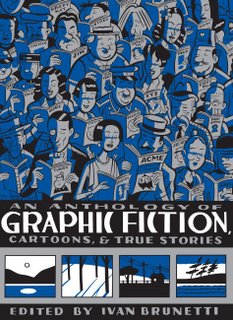UPDATE: This post has been somewhat edited from its original form.
 You know it’s a great year for comics when an anthology as strong as Ivan Brunetti‘s Anthology of Graphic Fiction, Cartoons, & True Stories isn’t an obvious front-runner. Considering its quality, the stature of its editor, and the publisher, this book hasn’t gotten as much hype as I might have expected, at least so far. Maybe it’s just Seth cover fatigue. (I hope the same syndrome doesn’t kill off the Dick Tracy series before it gets to the volumes set in outer space.)
You know it’s a great year for comics when an anthology as strong as Ivan Brunetti‘s Anthology of Graphic Fiction, Cartoons, & True Stories isn’t an obvious front-runner. Considering its quality, the stature of its editor, and the publisher, this book hasn’t gotten as much hype as I might have expected, at least so far. Maybe it’s just Seth cover fatigue. (I hope the same syndrome doesn’t kill off the Dick Tracy series before it gets to the volumes set in outer space.)
Of course, it might just be that most people who really follow comics are already familiar with most of the contents—or at least think they are—and are accordingly less likely to get enthused about a collection of comics they already know. (Of course, as I mentioned a while back, I’ve been surprised by some comics fans’ selective sense of comics history before, so there might be more unfamiliar material here than is apparent.)
Whatever the reason, this is a truly remarkable book, and I surprised myself by plowing through the first half in one sitting, even though I’ve read probably 90% of the material previously.
Brunetti has said that he conceived of the book as something like a Norton anthology for comics, collecting the work of the very best and most (artistically) successful North American cartoonists of the last thirty years, and for the most part, his selections are impeccable. It’s difficult (though not impossible — no Gilbert Shelton? No Jack Jackson? Etc.) to think of important cartoonists from the last three decades who aren’t represented.
Of course, not all of the cartoonists here work best in short form, so some of the selections don’t show the artists at their strongest or most representative. And considering the general thrust of the anthology, some of the selections are odd, and lead the reader to wonder. Why include five pages of pre-WWII comic strips and ignore nearly every newspaper strip from later years (other than Barnaby and Peanuts)? Why leave out so many artists from the underground days? Why include outsider artist Henry Darger, and once you have, why not include a half-dozen others? For that matter, why pick so many young cartoonists who may not actually belong in a book of this type yet?
At least part of the answer to these questions is that the book as originally planned was much longer. Yale decided it needed cutting, and Brunetti had to remove a big chunk of the book. (On a panel at this year’s Small Press Expo in Bethesda, he said that he found it a lot easier to cut out the work of dead cartoonists than live ones, which explains the chronological lopsidedness.) The other, more important, part of the answer lies in the personal nature of the book, something Brunetti is clear about in his introduction, where he writes that his “criteria were simple: these are comics that I savor and often revisit.”
That he took the criteria seriously is evident throughout the book—all of these comics repay rereading—and many of the more obscure or idiosyncratic choices help give the book a much more individual-feeling tone than you would usually find in an historical anthology. Brunetti writes that he sought to highlight “vital, highly personal work”. His own cartooning has always been highly personal, so it’s no surprise that he would value the trait in others. It is nice to find that he approaches his editing from a similar perspective.
In fact, half of the fun in this book is following the thought process implied by his selections, and their placement. The anthology opens with a page of Sam Henderson, followed by a Mark Newgarden section, which is not unlike a Norton anthology of twentieth-century theater beginning with a Marx brothers sketch, followed up with an excerpt from Waiting for Godot. With an opening salvo like that, you know the editor’s on the side of the angels.
Basically, the book may or may not be worth your money if you already own a lot of this work (if you do, you have a great library), but it’s still probably the finest anthology of so-called alternative comics yet published. It certainly beats the hell out of the lousy book that the Smithsonian put out a couple years ago. For someone who wasn’t already immersed in the field and its history, and wanted to learn more, this is just about as perfect an introduction as I can imagine. And even if you consider yourself a full-on aficionado, there are still bound to be at least a few revelations here, whether in discovering a comic you’ve never read before, or in re-experiencing a comic in a new context, one planned by an expert and a clear lover of the form.
[DISCLOSURE: My wife, Lauren R. Weinstein, was one of the contributors to this anthology.]









